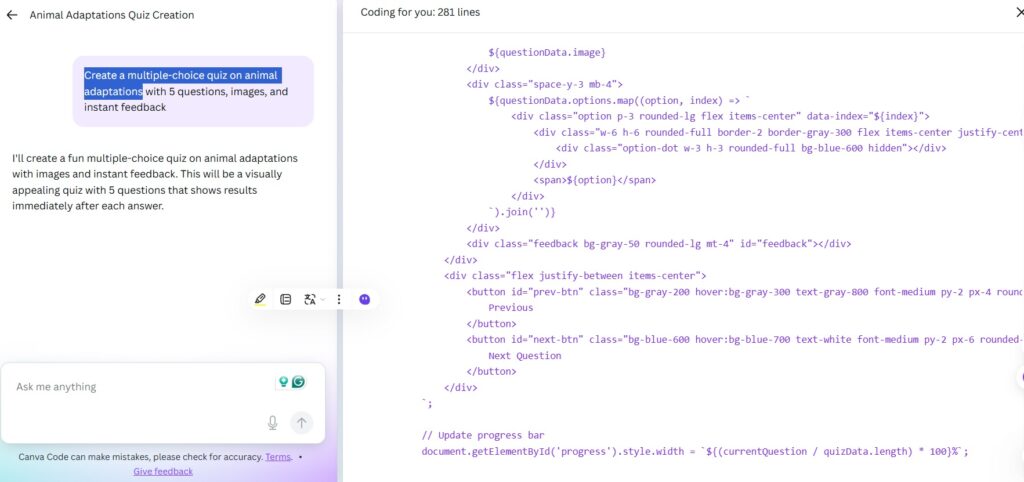Canva Code is Canva’s newest AI-driven feature that lets you generate websites, interactive apps, quizzes, and more entirely from text prompts without writing a single line of code. I first stumbled upon it when I needed to prototype a classroom quiz in minutes, and was amazed at how polished the output was, complete with responsive design and embed-ready snippets. In this deep-dive review, you’ll learn exactly how Canva Code works, see real-world examples (including student projects), discover pricing tiers, weigh the pros and cons.
What is Canva Code?
Canva Code is part of Canva’s Visual Suite 2.0, launched at Canva Create 2025 on April 10, 2025. It leverages generative AI models to turn simple text prompts into fully functional HTML, CSS, and JavaScript—even complete interactive elements—directly within the Canva ecosystem.
Key highlights include:
- No-code AI generation: Describe the app or webpage you want, click “Code for me,” and watch the AI build it in minutes.
- Design integration: Import generated code into any Canva design as a live preview or embed element.
- Publish instantly: Host on a free Canva domain or your custom domain with one click.
How to Use Canva Code in AI Code Generator in Canva?
- Open the Canva App or browser.
- Log in and click on the centre top, click on Canva AI.
- Then select “Code for Me.”
- In the prompt box, type what you need—e.g., “build an interactive quiz on ecosystems.”
- Hit Generate, wait a few seconds, and voilà—your custom code appears in the sidebar.
- Drag “Use in a design” onto your canvas, or export via Canva code generator for external hosting.
No more hunting for obscure promo pages or discount coupon fields—everything is right there in the AI interface.
Personal Experience in generating with Canva
My “Aha!” Moment
Last month, I had to Create a multiple-choice quiz on animal adaptations. Normally, I’d spend hours coding or wrestling with plugins. Instead, I opened Canva, typed “Generate a multiple-choice quiz on animal adaptations with images,” and had a responsive quiz within two minutes that I could embed in my classroom website. The results:
- Responsive by default: The quiz scaled neatly on mobile and desktop.
- Editable prompts: I tweaked questions directly in Canva’s AI sidebar and regenerated on the fly.
- Polished visuals: Canva automatically styled the quiz to match my school’s branding.
This experience shaved almost 80% off my usual development time, allowing me to focus on pedagogy instead of debugging code. The seamless blend of design + code truly felt revolutionary.
Key Features
“Code for Me” Prompt Interface
- Pre-built templates: Access sample prompts (e.g., “create a portfolio site,” “build a quiz”) to learn best practices .
- Natural language: No syntax required—just plain English instructions.
Live Editing & Preview
- In-editor preview: Instant feedback on both desktop and mobile layouts.
- One-click design import: “Use in a design” button moves the code into Canva’s editor as an interactive element.
Export & Publishing Options
- Free Canva domain: Launch prototypes at yourname.canva.site.
- Custom domains: Connect your own URL if you have a Canva Pro or Enterprise plan.
Code Elements Library
- Buttons, forms, galleries, charts: Auto-generated with accessibility best practices.
- AI-powered tweaks: Ask Canva Code to “make buttons blue” or “add hover effects.”
What are the Use Cases with Canva Code Generator
Student Projects & Classroom Activities
- Interactive quizzes: Science, history, language arts.
- Portfolio sites: Art and design students can showcase work in minutes.
- Data visualizations: Import spreadsheet data and generate charts using Canva Sheets integration.
Small Business & Entrepreneurs
- Landing pages: Launch promo sites or event pages without hiring developers.
- Email sign-up forms: Embed directly into social media posts or marketing funnels.
Developers & Prototypers
- Rapid prototyping: Generate front-end code to validate product ideas.
- Pitch decks: Embed live demos in investor presentations.
Pricing and Accessibility
| Plan | Code Features Included | Cost |
| Free | Free for generating | $0 |
| Pro | Unlimited generations; custom domain support; team sharing | $0 |
| Enterprise | SSO & permissions; premium support; API access | Contact sales |
- Free trial: 30-day Pro trial available for new users.
- Education accounts: Free Pro access for eligible schools makes Canva Code essentially free for students.
Pros and Cons
Pros
- Lightning-fast prototyping: Go from idea to demo in minutes.
- No technical barrier: Perfect for beginners and non-coders.
- Seamless design integration: Combines Canva’s design tools with coding outputs.
- Accessible: AI writes semantically correct HTML with accessibility tags.
Cons
- Basic tech stack: Outputs plain HTML, CSS, JS—no React, Next.js, or backend logic.
- Limited editability: You cannot directly tweak code in the editor—must regenerate on changes.
- Performance at scale: Struggles with projects over ~500 lines of code (complex apps).
- AI hallucinates: Occasionally introduces broken links or mismatched CSS classes.
Conclusion
Canva Code is a game-changer for students, educators, small businesses, and design-first developers who need rapid, no-code prototypes. While it isn’t a full replacement for traditional development frameworks, its ease of use, speed, and integration with Canva’s Visual Suite make it indispensable for quick-turn projects. If you’re new to coding or need to move fast, Canva Code deserves a spot in your toolkit.
FAQ’s related to Canva Code Generator
What is Canva Code?
Canva Code is an AI-powered feature in Canva that generates HTML, CSS, and JavaScript from text prompts.
Is Canva Code free?
yes, Canva code is free for all.
How to Find and Use Canva Codes Easily?
Log in → Canva AI icon → “Code for Me” → type prompt → generate → embed
How do I find Canva Code?
Log in, click the purple “Canva AI” icon in the top bar → select “Code for me”.
Can I edit the generated code?
Not directly—changes require regenerating via new prompts.
How to Use Canva Code Generator?
The “Code for Me” button is your generator: supply a text prompt and hit generate.
How to Use Canva Code AI for Beginners?
Start with templates, review generated HTML/CSS, then tweak prompts to learn.
What kinds of Canva Code Elements can I generate?
Buttons, forms, quizzes, charts, galleries, modals, and more—complete with accessibility tags.
Can I integrate generated code into other platforms?
Yes—export the code package or host on your own server; embed via iframe or direct link.
Does Canva Code Launch support custom domains?
Available for Pro and Enterprise plans—simply enter your DNS settings in the site publishing panel.
When was Canva Code released?
Announced April 10, 2025 at Canva Create 2025, rolled out gradually over late April 2025.
What types of projects can I build?
Websites, quizzes, calculators, games, landing pages, dashboards, and more.
Does it support AI-generated code snippets?
Yes—ask for specific components like forms, charts, and interactive galleries.
Is there a Canva Code generator?
The “Code for me” interface acts as the generator. You provide prompts; Canva AI returns code.
Can I integrate Canva Code with other Canva tools?
Absolutely. Use within designs, embed in spreadsheets (Canva Sheets), or incorporate in presentations.
Is Canva Code safe for commercial use?
Yes—generated code comes with a royalty-free license for use in personal and commercial projects.


